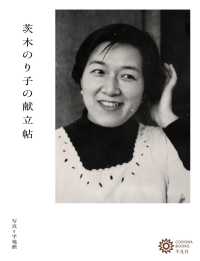- ホーム
- > 洋書
- > 英文書
- > Science / Mathematics
Full Description
The field of antibody engineering has become a vital and integral part of making new, improved next generation therapeutic monoclonal antibodies, of which there are currently more than 300 in clinical trials across several therapeutic areas. Therapeutic antibody engineering examines all aspects of engineering monoclonal antibodies and analyses the effect that various genetic engineering approaches will have on future candidates. Chapters in the first part of the book provide an introduction to monoclonal antibodies, their discovery and development and the fundamental technologies used in their production. Following chapters cover a number of specific issues relating to different aspects of antibody engineering, including variable chain engineering, targets and mechanisms of action, classes of antibody and the use of antibody fragments, among many other topics. The last part of the book examines development issues, the interaction of human IgGs with non-human systems, and cell line development, before a conclusion looking at future issues affecting the field of therapeutic antibody engineering.
Contents
List of figuresList of tablesList of acronyms, abbreviations, and definitionsForewordPrefaceAbout the authorsChapter 1: Introduction to biologics and monoclonal antibodiesAbstract:1.1 Introduction1.2 Definitions of biologies1.3 Recombinant protein therapeutics1.4 MAbs and Fc fusion proteins (FcFPs)1.5 General anatomy of a therapeutic IgG MAb1.6 Naming convention for antibodies from different sourcesChapter 2: Value proposition for therapeutic monoclonal antibodies and Fc fusion proteinsAbstract:2.1 Overview of discovery and development of therapeutic MAbs and FcFPs2.2 Market for MAbs and FcFPs2.3 Currently and recently approved MAbs and FcFPsChapter 3: Antibody structureaEURO"function relationshipsAbstract:3.1 Introduction3.2 Constant region structure/function3.3 FAb structure/functionChapter 4: Fundamental technologies for antibody engineeringAbstract:4.1 Introduction4.2 Hybridoma technology - the gateway for therapeutic monoclonal antibodies4.3 Key recombinant DNA technologies4.4 Generation of chimeric antibodies4.5 Display technologies4.6 Maturity timelines for biologies technologiesChapter 5: Sources of antibody variable chainsAbstract:5.1 Human antibody gene organization5.2 Antibody gene rearrangement and diversity in vivo5.3 Sources of antibody diversity5.4 Class-switch recombination5.5 Human variable gene usage5.6 Variable region selection5.7 Variable genes from non-human species5.8 Use of variable genes from humansChapter 6: Variable chain engineering aEURO" humanization and optimization approachesAbstract:6.1 Introduction6.2 Chimerization6.3 Humanization6.4 Affinity optimizationChapter 7: Antibody interactions with the immune systemAbstract:7.1 Introduction7.2 Human Fc receptors7.3 FcRn and its effect on MAb and FcFP half-life7.4 Other Fc receptors of importance7.5 Complement activationChapter 8: Monoclonal antibody targets and mechanisms of actionAbstract:8.1 Properties of antibody targets8.2 Antibody mechanisms of action8.3 CD20 - example of a target for which multiple MOAs applyChapter 9: Therapeutic antibody classesAbstract:9.1 Human antibody overview9.2 Human IgG isotypes9.3 IgM9.4 IgAChapter 10: Antibody Fc engineering for optimal antibody performanceAbstract:10.1 Antibody engineering for decreased or increased effector function10.2 Current marketed MAbs and clinical candidates with modified Fc10.3 The effect of human Fc polymorphisms on disease and therapeutic index10.4 Fc engineering of IgGs to increase effector function10.5 Fc engineering for silenced effector function10.6 Fc RIIb-dependent suppression of immune response10.7 Antibody engineering for modulation of pharmacokinetics10.8 Tissue targetingChapter 11: IgG glycans and glyco-engineeringAbstract:11.1 Introduction to Fc glycosylation11.2 Non-glycosylated IgGs for lowered effector function11.3 Low- or non-fucosylated oligosaccharides result in higher ADCC11.4 Non-sialylated IgG glycans result in increased ADCC11.5 Sialylated IgG glycans may result in immunosuppressive effects11.6 High-mannose glycoforms11.7 FAb glycosylationChapter 12: Antibody fragments as therapeuticsAbstract:12.1 Introduction to antibody fragments and alternative formats12.2 FAb and scFv antibody fragments12.3 Domain antibodies, including nanobodies, IgNARs, and nanoantibodies12.4 Antibody size and tissue distribution12.5 Strategies for half-life extension of antibody fragments12.5.2 PEGylationChapter 13: Multiple antibody and multi-specificity approachesAbstract:13.1 Introduction13.2 Serum therapy13.3 IVIG13.4 Multi-antibody approaches13.5 Bispecific antibodies based on IgGs13.6 Bispecific antibody fragmentsChapter 14: FcFPs and similar constructs using FcAbstract:14.1 Introduction14.2 Receptor-FcFPs14.3 Traps: multi-ligand binding domains of different receptor chains fused to Fc region14.4 Soluble protein FcFPs14.5 Antibody fragment - Fc fusion proteins14.6 Fc peptide fusions as receptor agonist therapeutics14.7 Other FcFP structures14.8 Issues to consider with FcFPsChapter 15: Antibody-drug conjugatesAbstract:15.1 Introduction to antibody-drug conjugates15.2 Overview and anatomy of a typical ADC15.3 ADC antibodies and targets15.4 ADC chemical "warheads"15.5 ADC linkers15.6 Issues, limitations, and design of ADCs15.7 Radioimmunoconjugates15.8 Protein immunotoxins15.9 ADEPT15.10 Other ADC-like approachesChapter 16: Development issues: antibody stability, developability, immunogenicity, and comparabilityAbstract:16.1 Introduction16.2 Aggregation16.3 Lack of desired solubility16.4 Fragmentation16.5 Post-translational amino acid residue modifications16.6 Instability and isomerization of disulfide bonds16.7 Stability at low pH16.8 Glycosylation issues16.9 Immunogenicity16.10 BiocomparabilityChapter 17: Interactions of human IgGs with non-human systemsAbstract:17.1 Introduction17.2 Non-human primate IgGs and Fc receptors17.3 Mouse IgGs and Fc receptorsChapter 18: Cell line developmentAbstract:18.1 Introduction18.2 Process summary18.3 Key issues in cell line development18.4 Choice of cell line18.5 Mammalian cell lines18.6 Microbial cells18.7 Multiple cell lines in single batches18.8 Gene and vector optimization and selectable markers18.9 Other industry trendsChapter 19: Issues facing therapeutic monoclonal antibodiesfor the futureAbstract:19.1 Introduction to the future state19.2 Commoditization of the core underlying technologies19.3 Impact of follow-on MAbs and FcFPs19.4 Competition19.5 The continued need for, and limitation of, novel pre-clinically validated targets19.6 Payor pressure19.7 Pipeline in a product concept19.8 Companion diagnostics and patient segmentation19.9 Treatment with multiple antibodies and bispecific antibodies19.10 MAb and FcFP conjugates19.11 Biopharma in 2020 - the focus on BRIC19.12 SWOT analysis of therapeutic MAbs and FcFPs19.13 EpilogueUseful public websites related to antibody engineeringReferencesIndex








